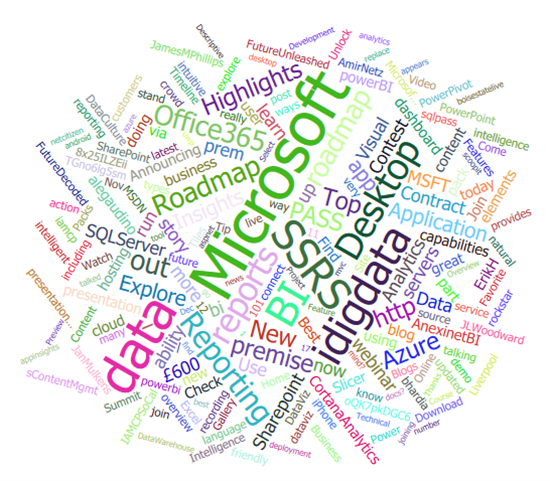By Amir Netz, Technical Fellow and Mey Meenakshisundaram Product Manager
A picture is worth a thousand word. But if you can present the words themselves as a picture, it’s worth even more. To make this art easy and fun for everyone, this week, Word Cloud is joining the growing Power BI custom visuals family.
The world of unstructured data is having explosive growth now with text content. you see text everywhere in the social media be in product reviews, comments, messages, announcements or even simply with status updates.
While Traditional charts and visualization techniques are great at making sense of structured data, they generally fall short when it comes to textual data. We often have to look for creative new ways for presenting text data. Word Cloud makes this experience exciting and fun in Power BI.
One word per line. Spiral: Archimedean Rectangular. Scale: log n √n n. The generated word clouds may be used for any purpose. About word clouds. A word cloud is an image made of words that together resemble a cloudy shape. The size of a word shows how important it is e.g. How often it appears in a text — its frequency. People typically use word clouds to easily produce a summary of large documents (reports, speeches), to create art on a topic (gifts, displays) or to visualise data (tables, surveys).
Word Cloud is a visual representation of word frequency and value. Use it to get instant insight into the most important terms in your data.
With the interactive experience of Word Cloud in Power BI, you no longer have to tediously dig through large volumes of text to find out which terms are prominent or prevalent. You can simply visualize them as Word Cloud and get the big picture instantly and user Power BI’s interactivity to slice and dice further to uncover the themes behind the text content.
This visual also puts you in control on the appearance of the work cloud, be it the size or usage of space and how to treat the data. You can choose to break the words in the text to look for the frequency word or keep word break off to project a measure as a value of the text. You can also enable stop words to remove the common terms from the word cloud to avoid the clutter. By enabling rotation and playing with the angles allowed, you can become very creative with this visual.
- In this video we show you How to Create Word Cloud using MS Word 2016 and Word Cloud AddonYT: https://www.facebook.com.
- The best way to make a word cloud in PowerPoint is to use an Online Word Cloud Generator. This is a smooth and flexible method that gives you the absolute best looking solutions. Keep in mind, however, the security, I don’t recommend you make word clouds with sensitive information.
- Word clouds are especially fun to customize because you can adjust the range of colors for the words within the cloud. Pick two different colors for you word cloud. The smallest words appear as one color, the largest words appear as the other, and everything in between appears as a gradient between the two.
Word Cloud is slick and adds a new dimension to the Power BI custom visuals experience. Check out this video to see this in action.
To use, simply import the Word Cloud from the Visuals gallery to your Power BI report and use it with a text column. Optionally you can also use a measure to provide weightage to the text. If none provided, it will simply use the frequency. Check out the formatting pane for more options.
As usual, we can’t wait to hear your thoughts and your ideas for improvements.
Enjoy!
Now, go, try it out and have some fun and explore your unstructured text data.
HideWord cloud settings
- sans-serif
- serif
- monospace
- Daniel
- Essays1743
- Gentium
- Gruenewald-VA
- Isabella
- Jura
- Sniglet
- Yiggivoo
Layout
Word clouds always scale to fit.
Size
Word list
0 were filtered from the original source.
Only display words found at least this often.
The highest frequency is 0.
- Display on word cloud
- Display (set by user)
- Do not display
- Do not display (set by user)
- Current word
- Recently modified word
0 match the filtering criteria.
 Original source
Original sourceSave
Make a word cloudOriginal source

Normal text
Copy and paste the text of your document or try an example.
By default, the more frequently a word is found, the larger it becomes in the word cloud.
For example, enter a table, or apply no filter if words do not repeat.
No filter
Text is repeated in the word cloud as given. It is not counted, filtered or sorted.
Table
Microsoft Word Cloud Tool
Copy and paste from a spreadsheet or manually enter your own.
Separate columns with a tab, comma, colon or a space (see examples).
Microsoft Word Cloud Storage
Separate by a space or a new line. Replace with default.
Each will be removed from the beginning or end of any word. Replace with default.
Microsoft Office Word Cloud Template
Each character is replaced by a non-breaking space, keeping words together.
